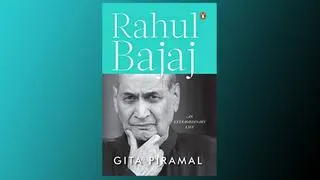Arguably, the most famous line in Christopher Nolan’s Prestige , a film that tracks an epic and tragic rivalry between two young and ambitious magicians, is: “Are you watching closely?” Because magic, an art of the detail, demands your close attention. The closer you watch, the sharper you focus, the better the experience (surprise). Jadoowallahs, Jugglers and Jinns: A Magical History of India by Australian scholar John Zubrzycki demands a similar experience from you.
And the results are extremely pleasing, one that leaves you amused to the core. Zubrzycki is a scholar of Indian magic and history. His previous works stand testimony to his unique expertise on the country and its history. He focusses on geographies and subjects that generally don’t fall on the radars of traditional historians.
In The Last Nizam (2012), Zubrzycki delved into the enchantingly tragic and chaotic life of the Nizams of Hyderabad, while in the racy thriller-biography The Mysterious Mr Jacob: Diamond Merchant, Magician and Spy, he followed the mysterious life of Alexander Malcolm Jacob, perhaps the most colourful character who ever lived in the country.
The Mysterious Mr Jacob had touched upon Indian magic and its history in bits and pieces, thanks to Jacob’s fascination for the mystery art. But in Jadoowallahs, Jugglers and Jinns, Zubrzycki takes the journey way forward by revealing hitherto unknown episodes from the history of magic in India.
“I found evidence of magic almost everywhere I looked,” he writes, “in the verses of the Atharva Veda , the stories of Somadeva and Dandin’s descriptions of Pallava society with its statues of Kama, the god of love and his consort, Rati, making erotic sounds...”
Magic has been an integral part of India’s history. Zubrzycki says evidence of magical rites can be found in Harappan culture beginning in about 2600 BC. Zubrzycki’s general thesis is impressive. He, rightly, says that to tell the story of Indian magic is to “hold a mirror to India’s religious traditions, its society and culture”.
Zubrzycki’s canvas is ostensibly large and wide. He starts by looking at how magic “permeated” the Vedic period, how Sufis and yogis staged miracle contests to see whose jadoo was more powerful, how Buddhists and Jains resorted to spells and incantations to win philosophical debates, and more.
Across continents
The story of Indian magic cannot be told without examining its place in the globalisation of popular culture and the interplay between Eastern and Western traditions of performance magic, writes Zubrzycki. Hence, his narrative criss-crosses continents, following magicians, emperors, troupes, tricks and secrets of magical performances — ancient and modern.
Zubrzycki’s dramatic persona is quite impressive. From ancient jugglers and jadoowallahs who mesmerised the public as well as kings (the likes of Professor Ahmad of Charkhari, who was the court magician of Maharajah Mulkan Singh of Agra), to the modern Maharaja of Indian magic, Protul Chandra Sarkar aka PC Sorcar, he casts deep and wide to cobble up a cogent narrative of Indian history that is marked with mysteries and tragedies, considering the way history has treated these players, by pushing them to the margins, forcing many such tribes to vanish into thin air or into unknown ghettos, as unsung heroes.
The book is a magic lover’s delight. It explores a series of tricks and their journeys from India to lands abroad and back and how in that process the tricks and their many practitioners have imbibed new cultures and improvised upon their skills only to make Indian magic an art of elegance and enigmatic complexity.
From the Basket Trick, one of the oldest and “most mystifying feats of magic in the world”, to the Indian Rope Trick and the dangerous escape acts, Zubrzycki explores them all, unravelling layer after layer of hidden histories that speak volumes about the peculiarities of the Indian peninsula.
Zubrzycki’s anecdotes are rare gems. He dives into unknown depths of history and bring up characters that amuse you to no limits. Take Kalanag, who Zubrzycki likens to PC Sorcar. The name sounds very Indian. In fact, his real name was Helmut Ewald Schreiber, and he borrowed his stage name from the black snake kala nag , in Rudyard Kipling’s Jungle Book . Kalanag was Adolph Hitler’s favourite magician. He performed for Luftwaffe troops in Lapland and Blitzkrieg divisions in France, writes Zubrzycki.
When the American Third Army captured Munich in the closing days of the war, he played for General Patten and convinced a Hamburg court he had never been a member of the Nazi Party. With his wife Gloria de Vos, hailed as the most beautiful woman in magic, he took his Sim Sala Bim show around the continent and to England, where it was enthusiastically received despite the German’s connection with the country that nearly bombed most of its neighbours out of existence, reveals Zubrzycki. The book is rich with several such interesting stories.
Zubrzycki dedicates a good amount of time to discuss the skills and repertoire of Bengal magicians. He explores the life and career of PC Sorcar in great detail, especially how his global success has given a new lease of life to Indian magic after years of neglect.
That said, the book’s omission of the rich magical traditions of Kerala and Tamil Nadu and other southern States is tad disappointing. From Vazhakunnam Neelakandam Namboothiri, a legendary magician who many call the Great Grand Dad of Magic in Kerala, to his disciple Gopinath Muthukadu, south India boasts a rich tradition of magic.
To be fair, Zubrzycki says that he is “acutely aware” that as a Westerner, his perception of what is magical in India’s performing arts, literature, society, religion and culture will differ from an Indian’s. Still, one would expect a little more nuance from a scholar of his depth. Despite such blemishes, Jadoowallahs, Jugglers and Jinns can easily top the reading list of all students of Indian history. Such works happen very rarely.







Comments
Comments have to be in English, and in full sentences. They cannot be abusive or personal. Please abide by our community guidelines for posting your comments.
We have migrated to a new commenting platform. If you are already a registered user of TheHindu Businessline and logged in, you may continue to engage with our articles. If you do not have an account please register and login to post comments. Users can access their older comments by logging into their accounts on Vuukle.